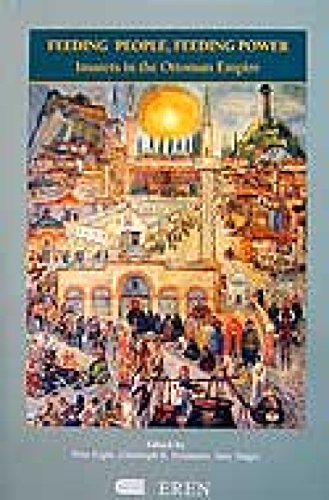Articoli correlati a FEEDING PEOPLE FEEDING POWER

Le informazioni nella sezione "Riassunto" possono far riferimento a edizioni diverse di questo titolo.
- EditoreEren Yayıncılık
- Data di pubblicazione2017
- ISBN 10 9756372397
- ISBN 13 9789756372395
- RilegaturaCopertina flessibile
- Numero edizione1
- Numero di pagine312
Compra nuovo
Scopri di più su questo articolo
Spese di spedizione:
EUR 18,00
Da: Turchia a: U.S.A.
I migliori risultati di ricerca su AbeBooks
Feeding people, feeding power: Imarets in the Ottoman Empire.
Descrizione libro Soft cover. Condizione: New. Paperback. Pbo. Roy. 8vo. (24 x 17 cm). In English. 312 p., b/w and color ills. Feeding people, feeding power: Imarets in the Ottoman Empire. Imarets have long been recognized as one signature institution of the Ottoman Empire. These public kitchens were typically located in mosque complexes or multi-structured complexes, which included some or all of the following buildings: mosque, medrese, mekteb, tomb, caravansaray, sufi tekke (or tekye) , hospital, bath, market, and other structures associated with the social, economic, and cultural life of the population, usually in an urban setting. Studying imarets is yet another way to explore the Ottoman vision of conquest, empire-building, and imperial rule. The imarets were part of the multiple Ottoman provisioning systems supporting the imperial palaces, military campaigns, cities, and the annual hajj caravan to Mecca and Medina. The public kitchens operated in a society where the state and beneficent institutions held a continual and considerable role in contributing to the daily subsistence of all kinds of individuals. Ultimately, the Ottoman sultan's preoccupation with food was in part an outgrowth of his political and military capacities, and his general responsibility to provide for his subjects. Although the precise dynamic of the emergence of imarets as a distinct institutional form is a process that remains to be traced, it was clearly a confluence of historical practices, together with the demands placed on the early Ottoman sultanate, that gave rise to the particular form of the imaret. Evliya Celebi remarked that in all his travels he saw "nothing like our enviable institution." At least one architectural historian claims that no earlier structures have been found that are analogous and certainly none are described in general books on Islamic architecture. The particular Ottoman origin of the imaret as a distinct architectural form is also attested by its presence throughout the Ottoman lands, Anatolia, the Balkans, and the Arab provinces, regions that did not necessarily share institutions in the pre-Ottoman period. Entirely unexplored remains the impact of Byzantine practices of charity on the Ottoman imarets. The daily distribution of cooked meals to large numbers of urban dwellers year-round from a special building designed for that purpose thus appears to have been an Ottoman innovation, at least outside the holy cities of Mecca and Medina, and of Hebron. Codice articolo 022285
Feeding people, feeding power: Imarets in the Ottoman Empire.
Descrizione libro Soft cover. Condizione: New. SINGER, AMY - CHRISTOPH K. NEUMANN - NINA ERGIN (Edited by) Feeding people, feeding power: Imarets in the Ottoman Empire. Istanbul: Eren Yayincilik, 2007. Large 8vo., 312 p., ills. Paperback. New ISBN: 9789756372395 CATALOG: Ottoman history KEYWORDS: Ottoman Empire Ottoman religieus system Imarets have long been recognized as one signature institution of the Ottoman Empire. These public kitchens were typically located in mosque complexes or multi-structured complexes, which included some or all of the following buildings: mosque, medrese, mekteb, tomb, caravansaray, sufi tekke (or tekye) , hospital, bath, market, and other structures associated with the social, economic, and cultural life of the population, usually in an urban setting. Studying imarets is yet another way to explore the Ottoman vision of conquest, empire-building, and imperial rule. The imarets were part of the multiple Ottoman provisioning systems supporting the imperial palaces, military campaigns, cities, and the annual hajj caravan to Mecca and Medina. The public kitchens operated in a society where the state and beneficent institutions held a continual and considerable role in contributing to the daily subsistence of all kinds of individuals. Ultimately, the Ottoman sultan?s preoccupation with food was in part an outgrowth of his political and military capacities, and his general responsibility to provide for his subjects. Although the precise dynamic of the emergence of imarets as a distinct institutional form is a process that remains to be traced, it was clearly a confluence of historical practices, together with the demands placed on the early Ottoman sultanate, that gave rise to the particular form of the imaret. Evliya Celebi remarked that in all his travels he saw ?nothing like our enviable institution.? At least one architectural historian claims that no earlier structures have been found that are analogous and certainly none are described in general books on Islamic architecture. The particular Ottoman origin of the imaret as a distinct architectural form is also attested by its presence throughout the Ottoman lands, Anatolia, the Balkans, and the Arab provinces, regions that did not necessarily share institutions in the pre-Ottoman period. Entirely unexplored remains the impact of Byzantine practices of charity on the Ottoman imarets. The daily distribution of cooked meals to large numbers of urban dwellers year-round from a special building designed for that purpose thus appears to have been an Ottoman innovation, at least outside the holy cities of Mecca and Medina, and of Hebron. Codice articolo 35984

